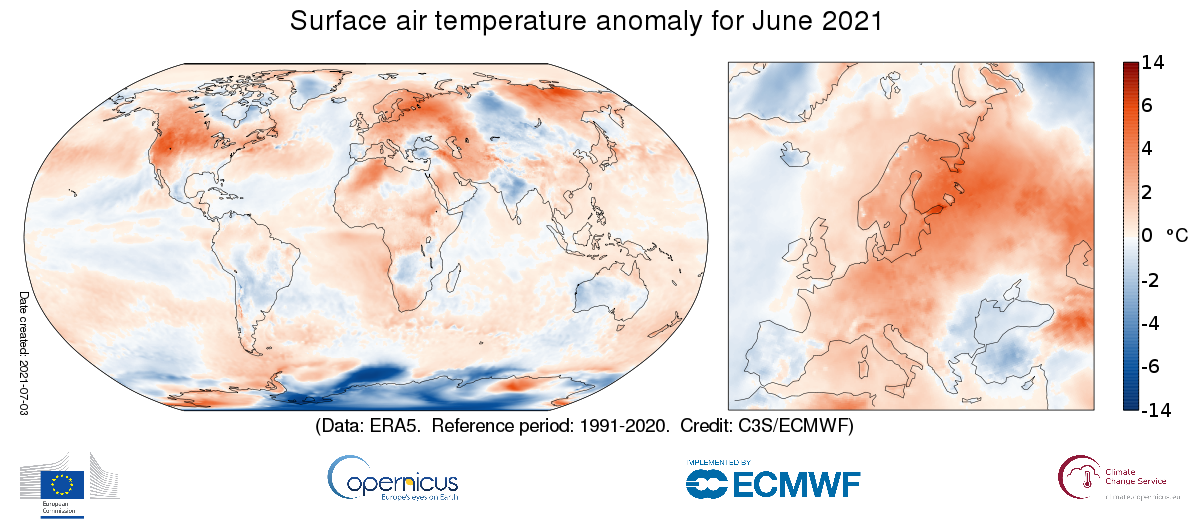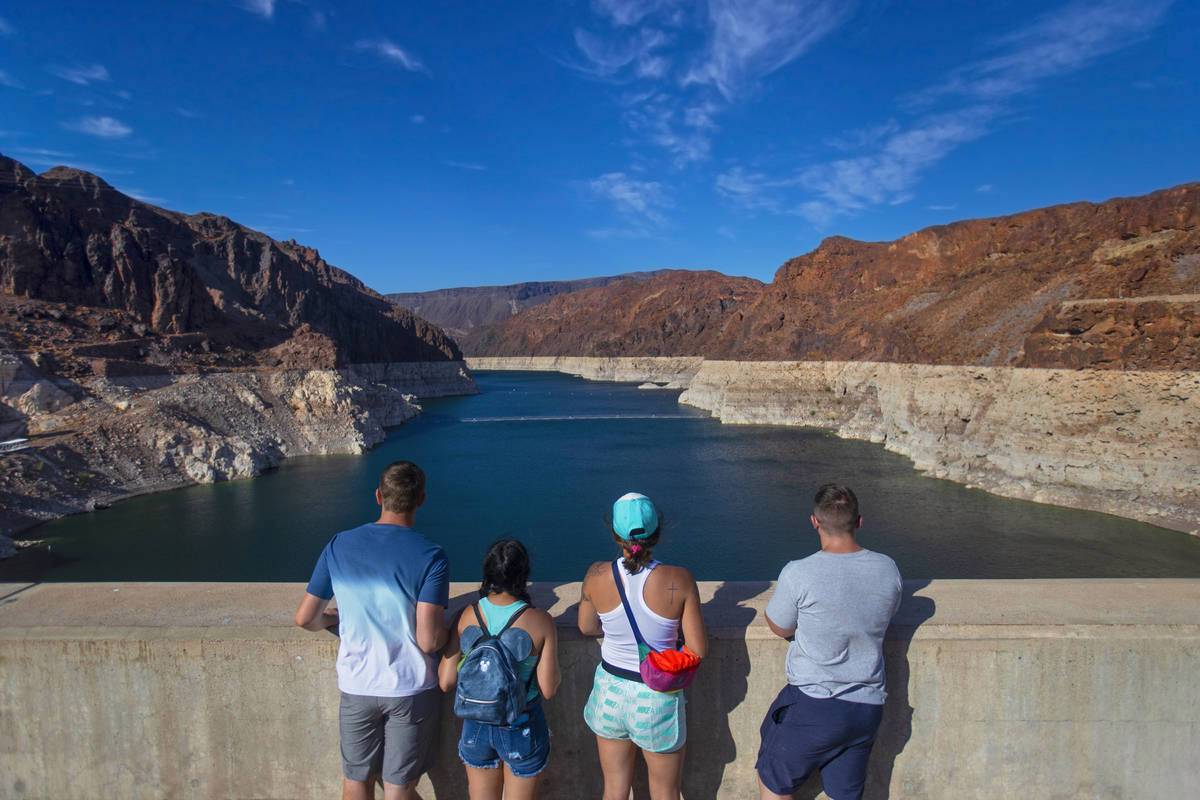By Glynn Wilson –
WASHINGTON, D.C. — James Rhodes of Coulterville, California can attest to how hot it was in June, even at 1800 feet above sea level in the shadow of Yosemite National Park and only a three hour drive from San Francisco.
“It’s been really hot,” he said, with one wildfire in the area already and wildfire season has only just begun, along with recent reports of mountain lions attacking livestock and dogs in the area.
“Climate change is driving them here,” he said. “And it’s not over yet.”
Scientists with the Copernicus Climate Change Service, an agency supported by the European Union, released a new report Wednesday morning showing that North America experienced its hottest June on record. The average temperature was more than 2 degrees Fahrenheit higher than the average from 1991-2020 and providing more evidence that industrial emissions of carbon dioxide and other heat-trapping gases from human activities are warming the planet to near the breaking point and changing the climate irreparably.
The average surface temperatures for June in North America were about one-quarter of a degree Fahrenheit (0.15 of a degree Celsius) higher than the average for June 2012, the year holding the previous record for heat, the agency said, showing it was the second hottest June on record for Europe and the fourth hottest for the planet overall.
“The warm region over Europe peaked in the north-east, and extended south-westward to North Africa and south-eastward as far as Iran and Pakistan,” the agency said. “Heatwave conditions persisted over western North America, where many temperature records were broken.”
Arctic Siberia also experienced high temperatures and its fourth warmest June ever, on a par with June 2012 when Antarctic temperatures were predominantly colder than usual, the report says.
Small towns like Lytton, British Columbia, in Canada, also broke all-time temperature reading records three days in a row as the high soared to 121 degrees, days before the village largely burned to the ground as extreme wildfires spewed smoke and ash 55,000 feet into the sky.
California’s Death Valley once again climbed into the upper range of the 120s to near 130 degrees, setting another record as the hottest place on the planet. Las Vegas was baking at 115 degrees as Medford, Oregon reached 103 degrees and Boise, Idaho hit 102.
At Lake Mead, the largest reservoir in the United States backed up by the Hoover Dam, the water level dropped to about 1,072 feet recently — a low not seen since it was filled in the 1930s. It supplies fresh water for 40 million people in Arizona, California, Colorado, Nevada, New Mexico, Utah and Wyoming, and officials said its water level could fall even farther.
The small former gold rush community of Coulterville, with an official population of 115, is a monument to another time., according to the Mariposa County web site.
The Hotel Jeffery, built in 1854, has entertained the likes of President Theodore Roosevelt and Sierra Club founder John Muir — both of whom would be appalled at the heat — and they say the large, historic bar is worth a look, “even if you don’t order a drink.”
It might take a few drinks to cool off in this heat, or you could jump in what’s left of Lake McClure or Lake Don Pedro, although experts issued the first ever warning that the Colorado River is at serious risk of drying up.
Twenty-eight miles south from Coulterville is the town of Mariposa, where the Big Oak Flat entrance to Yosemite on Highway 120 is just twenty miles east.
For Yosemite travelers, Highway 132 — officially designated as a Historic John Muir Route — provides a scenic, laid back alternative to the caravans of RVs, trailers and lead-footed drivers that can make Highway 120 a frustrating journey, according to the town, especially in the summer travel season.
The most brutal climate conditions were experienced in the Western United States and Southwestern Canada, according to reports, where a prolonged and intensifying severe drought has shriveled crops, threatened water supplies and contributed to what is shaping up to be a severe wildfire season.
An enormous “heat dome†of high-pressure air stalled over the West, and impacted the Pacific Northwest, a region where until recently air conditioning had been seen as an afterthought. Heat-related deaths soared.
Temperatures were also above average in Northwestern and Southern Africa, across parts of the Middle East, and in China and much of Southeast Asia. High temperatures in Arctic Siberia contributed to an early start to wildfire season there.
Much of the United States is likely to remain hotter than normal for the rest of the summer, according to the most recent analysis by the National Oceanic and Atmospheric Administration.
Overall, according to the analysis, 2021 is virtually certain to be among the 10 warmest years ever recorded.
The June heat was relentless across most of the United States and Canada, and cooler conditions only existed in parts of the Southern Plains, the Southeast, Northern Canada east and west of Hudson Bay, and higher elevations in the mid-Atlantic region, in places like Shenandoah National Park and the Catoctin Mountains in Maryland.
But the cooler temperatures in the East and South are about to change, and the first Atlantic-Gulf tropical storm of the season is about to hit the west coast of Florida. Tropical Storm Elsa, which weakened overnight from a Category 1 hurricane, was expected to make landfall along Florida’s Gulf Coast by late Wednesday morning or early afternoon, the National Hurricane Center reported.
As of 8 a.m. Eastern time, the storm was about 70 miles west-northwest of Tampa, Fla., with maximum sustained winds of 65 miles per hour. The storm was moving north at 14 m.p.h.
Elsa, which passed near the Florida Keys on Tuesday dumping up to nine inches of rain, has the potential to dump up to nine inches of rain in some parts of the state before moving across the Southeast and into the Mid-Atlantic States through Thursday.
Elsa cut through Cuba on Monday, bringing gusty winds and torrential rains and felling trees and electricity cables in some cities. It formed as a tropical storm last week, and is the fifth named storm of the 2021 Atlantic hurricane season.


















Earlier in the week, we had a fire near Dog Town Road, took about 9 fire trucks and a bull dozier (?) with about a 15′ blade, to keep it under control. I’m not sure what caused it but I am really disgusted with idiots-alleging “patriotism”-setting off illegal fireworks. During last season’s fire, we ignored a mandatory evacuation order (many of us here are combat veterans) to assist with livestock that ranchers were unable to move-during that blaze I counted over 30 fire trucks-the smoke was so think, the sky vanished and embers fell like rain. Thank God winds were low!